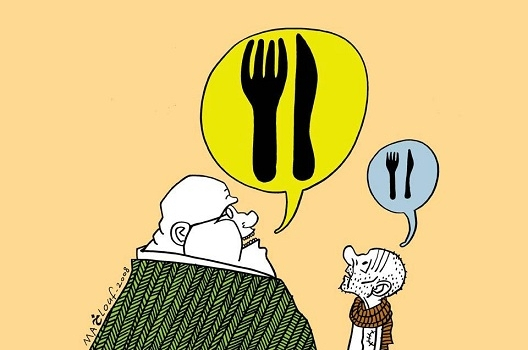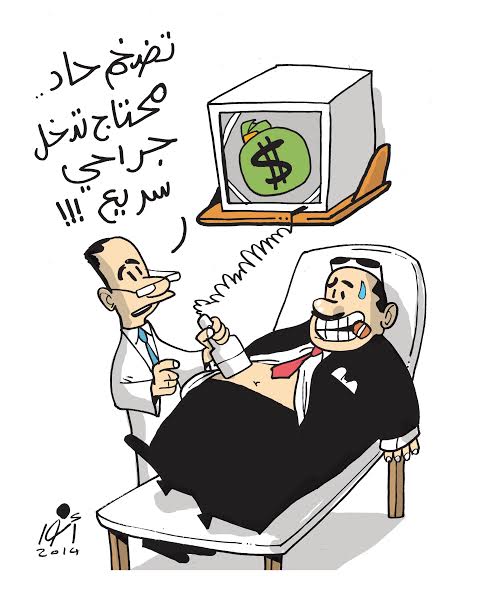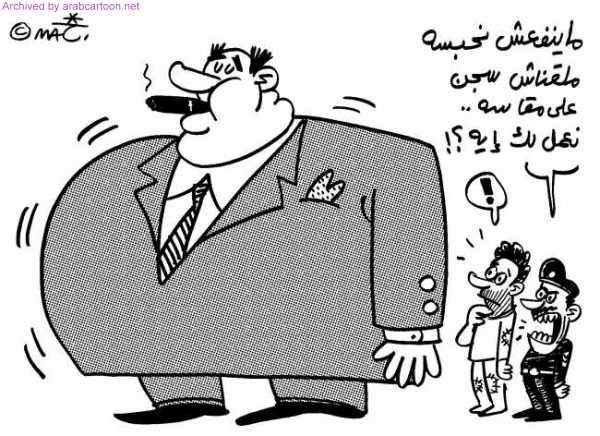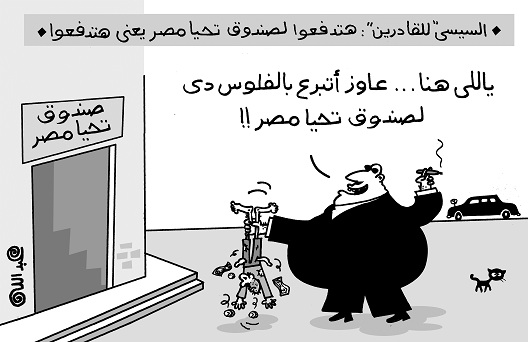 Last week, the privately-owned and widely-circulated Egyptian newspaper Al-Masry Al-Youm published three political cartoons about corruption in a single day. It’s not unusual to print so many illustrations in one edition; the paper sometimes publishes a dozen comics in a day. But what can we make of three independent cartoonists devoting their frame to criticizing Big Money?
Last week, the privately-owned and widely-circulated Egyptian newspaper Al-Masry Al-Youm published three political cartoons about corruption in a single day. It’s not unusual to print so many illustrations in one edition; the paper sometimes publishes a dozen comics in a day. But what can we make of three independent cartoonists devoting their frame to criticizing Big Money?
The slew of cartoons on corruption follows a longstanding trend. For years, Egypt’s endemic corruption has always been the butt of many a joke. The great illustrators of the 1950’s used rich men as punch lines in the Egyptian press, too. That young illustrators so venomously caricatured the business elite in this week’s press might counter-intuitively signal the shrinking, rather than the opening, of political space. While papers have published dozens and dozens of cartoons on the broad topic of corruption, editors have rejected more explicit criticism of the players and institutions of government.
Like everywhere in the world, money has a corrupting effect on Egyptian politics, and politics often returns the favor. Since the 2011 uprising, calls for reform have yet to stem the tide of corruption. Bad investment laws have enabled further dereliction. Tycoons have stolen public assets. Earlier this year, Egypt’s Central Auditing Organization—a watchdog that barks but doesn’t bite— claimed that the state has misspent 70 billion Egyptian pounds. 
Caption: “You are seriously bloated… You need surgery, quick!!!” says the doctor to the cigar-chomping fat cat. The cartoon is perhaps a criticism of Big Business’s squandering of public funds and crooked tactics of tax evasion. (Anwar, Al-Masry Al-Youm, August 8, 2014)
Egyptian artists are tapping into a long-standing institution of caricature. American cartoonist Thomas Nast rendered Boss Tweed in Harper’s Weekly, in the 1870’s, giving Big Money a funny face and bringing down the dishonest ringleader of Tammany Hall in the process. This is what cartoons were made to do: to hold the corrupt accountable. Cartoons, however, have not held such power in the US since the days of the Vietnam War: Los Angeles Times cartoonist Paul Conrad’s daily assaults on President Richard Nixon landed the ink slinger on that infamous enemies’ list. In Egypt, leaders still fear cartoons; they are vehicles for conveying the public mood and for crystalizing opposition voices. That’s why Egyptian illustrators face a complicated censorship regime, from activist editors and in the form of self-censorship.
The fat cat, the all-powerful and all-dishonest character, is an expression of the cartoonist’s capacity to serve as an ombudsman. From New York to Cairo, each cartoonist has brought his or her style to bear in depicting crooked men in suits, brandishing cigars and sunglasses and other symbols of opulence. Known as Mr. Moneybags in the US press, the character has a global resonance. “There’s something about the symbol of big money in politics that always bends toward the pinstriped cigar-chomping fat cat,” writes cartoonist Matt Wuerker, winner of the 2012 Pulitzer for his contributions to Politico.

Caption: “We can’t imprison him… we couldn’t find a prison big enough for him. What can we do for you?” asks the policeman. A poor man stands beside the officer, befuddled and powerless in the face of the oversized fat cat. (Makhlouf, Al-Masry Al-Youm, August 10, 2014)
Indeed Mr. Moneybags is a regular character in Egyptian cartoons. Makhlouf, who draws daily for Al-Masry Al-Youm, has employed the character as shorthand for corruption since 2008. (As per the Egyptian tradition, most cartoonists use their last names as pen names.) Similarly, his fellow illustrators at the independent broadsheet, Anwar and Abdallah, often draw men in dark suits to comment on the news or to express discontent with wealth disparity and the class divide. The mirror image of the fat cat (and his nicely pressed suit) is the poor man, dressed in rags, who represents Egypt’s everyman. This simple binary is reinforced almost daily in the Egyptian newspaper.

The fat cat shakes down the poor man for his pocket change. The headline reads, “Sisi to those who can afford it: You’ll pay to the Long Live Egypt Fund meaning you’ll pay.’” Note the fat cat’s limo waiting in the background, and the ragged clothes of the everyman. Abdallah reproduces the classic binary of poor versus rich, often on display in the Egyptian press. (Abdallah, Al-Masry Al-Youm, August 6, 2014)
But the fat cat cartoon might obscure the political scene. Can corruption in Egyptian institutions and companies be blamed on an anonymous man in a black pinstriped suit? Rather than fingering the actual tycoons and companies responsible for squandering money, cartoonists inadvertently spread the blame around an entire political class. It is certainly less risky than shining a torch on the military’s role in the economy or billionaires who have fled the country. Though the red lines of Egyptian caricature are constantly shifting, satirists persistently poke fun at business elites. The fat cat remains a permissible target.
Jonathan Guyer is the senior editor of the Cairo Review of Global Affairs. He blogs at Oum Cartoon. On Twitter: @mideastXmidwest.
Image: Makhlouf, Facebook, 2008
